Menus
- Enter new territory
- High fuel consumption
- Sit down, drive, after work
- A mere 305 kilograms
- Perfect condition after 50,000 kilometers
- Measured values, balance sheet, costs and maintenance
- Balance after 50,000 kilometers
- Costs and maintenance
- Reading experiences
- Honda takes a stand
- Offers used Honda Crosstourer in Germany
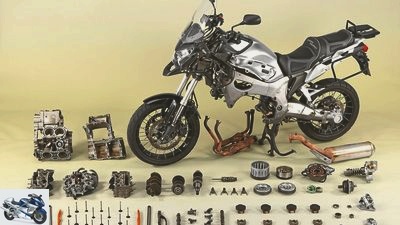
Bilski
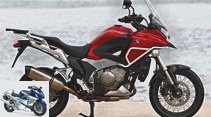
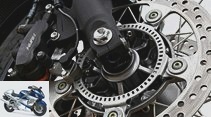
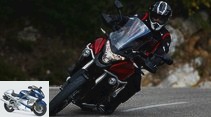
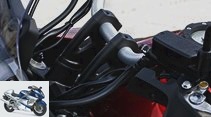
35 photos
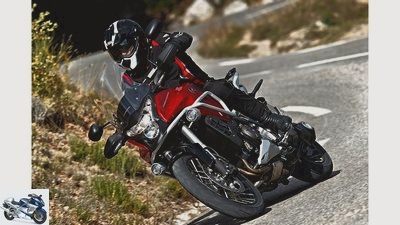
1/35
The V-shaped headlight says what’s going on: Here comes one
V4 machine brushed up. Your high touring screen costs extra.
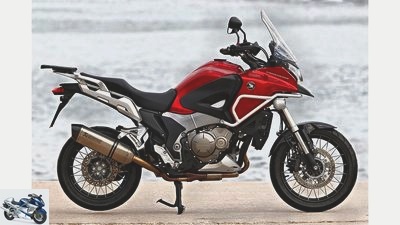
2/35
With an impressive 1237 m³, the Honda Crosstourer is one of the largest machines in its class.
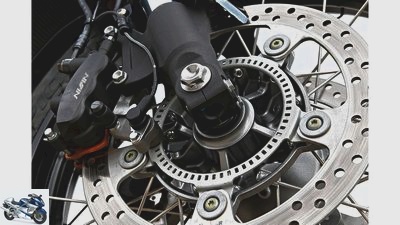
3/35
The brakes on the Honda Crosstourer are brilliant. Partly integral, the pedal also pinches at the front.
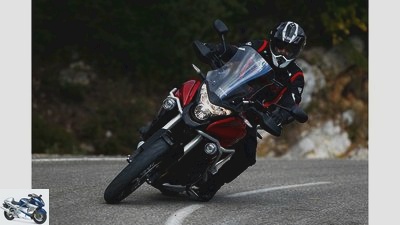
4/35
The smoothly running four-cylinder of the Honda Crosstourer starts evenly and powerfully under 3000 rpm. Accompanied by the subtle purr from the optional Akrapovic exhaust.
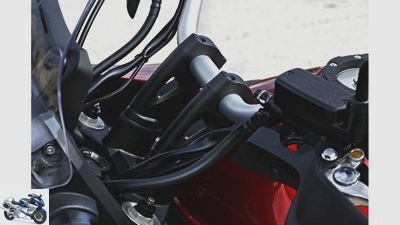
5/35
Enduro chopper: the handlebars rest on high risers. No wonder it is the highest on the test field.
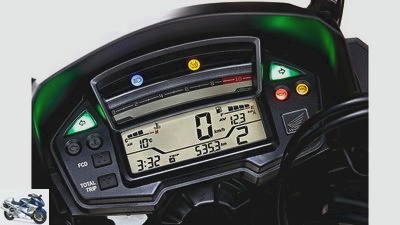
6/35
Search game: where is the tachometer? Unfortunately, the narrow LCD light strip shows imprecisely and roughly.
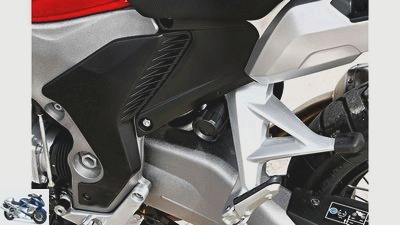
7/35
The engine of the Honda Crosstourer is hidden behind the cover.

8/35
The one-armed cardan has a homokinetic joint, but no external moment support.
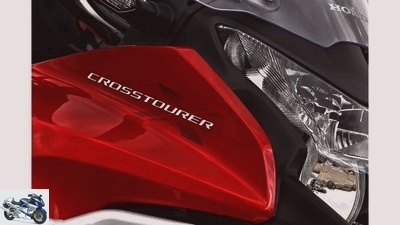
9/35
The logo of the Honda Crosstourer denounces the front.
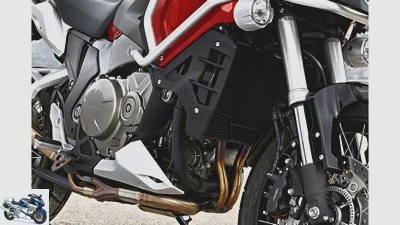
10/35
The 121 hp of the Honda Crosstourer is a decent achievement. However, the stunner also weighs an impressive 280 kilograms.
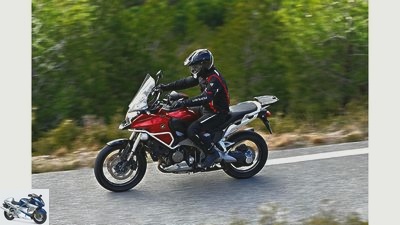
11/35
The seating position turned out to be strangely passive, not Honda-typical: it spreads its legs wide, although the two rear cylinders are closer together than the pair in front.
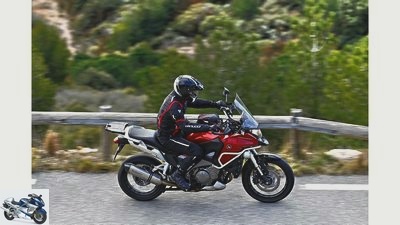
12/35
The uncomfortable, one-piece bench is unfortunately not height adjustable.
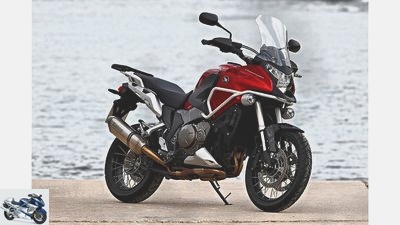
13/35
The Honda Crosstourer is a moose from a motorcycle. Big and tall, but also enduring and durable.
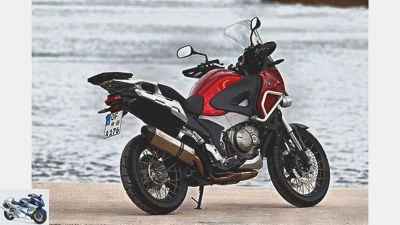
14/35
With its three-year warranty plus mobility guarantee, the Honda Crosstourer is ahead in terms of costs.
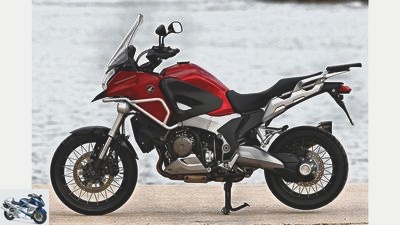
15/35
Own: aluminum bridge frame, built-in front, slim rear, long wheelbase, flat fork. Tubeless spoked wheels are standard, but Akrapovic exhaust and crash bars are extras.
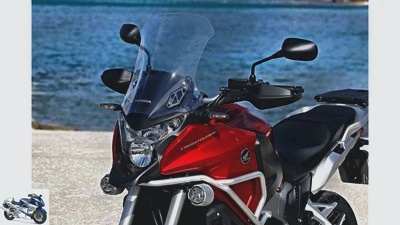
16/35
The high touring windshield we used in our test costs extra.
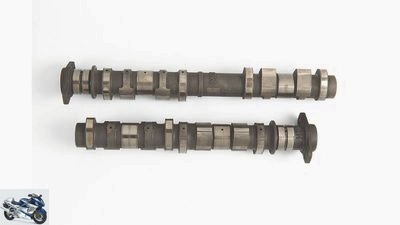
Bilski
17/35
The inlet valves, on the other hand, are operated directly by bucket tappets. The entire valve train is in top condition.
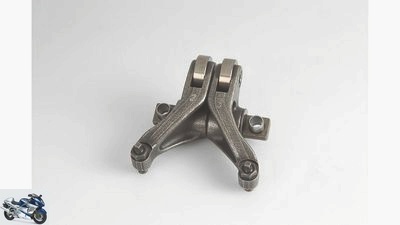
Bilski
18/35
Individual: With the “Unicam” system, thin roller rocker arms operate the outlet valves.
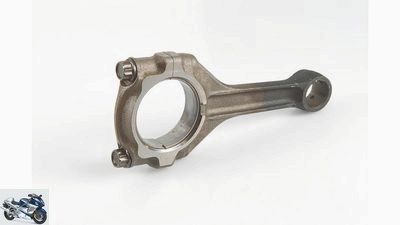
Bilski
19/35
Corpus Delicti: Three connecting rod bearings show slight traces of friction, on this one combined with broken material.
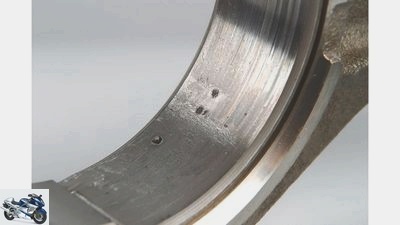
Bilski
20/35
The breakouts may come from foreign bodies during installation – so they are probably harmless.
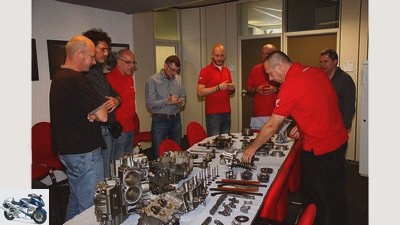
Hertler
21/35
Blue and red shirts: Honda employees Klaus Bescher (3rd from left), Oliver Franz (middle) and Guido Noewak (2nd from right) inspecting the interior of the engine.
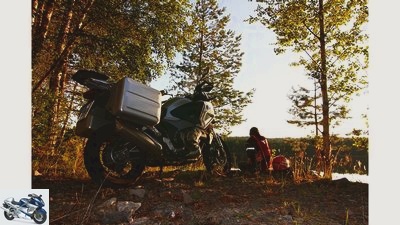
Blacksmith
22/35
With the Honda Crosstourer we went to lonely lakes in Sweden.
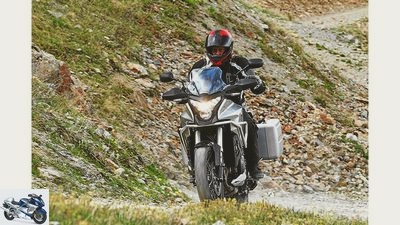
Gargolov
23/35
Off-road use cost overcoming because of the high weight and center of gravity.
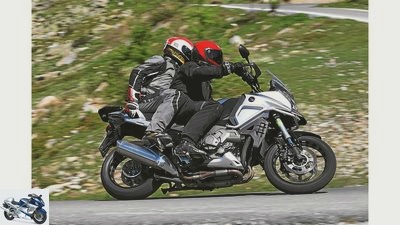
Jahn
24/35
With a passenger at the 2012 Alpine Masters.
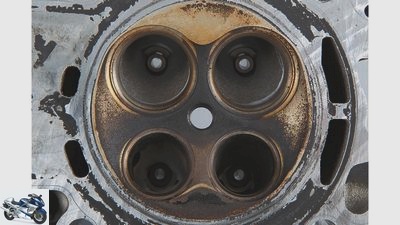
Bilski
25/35
Valve seat inserts and guides are flawless for 50,000 kilometers.
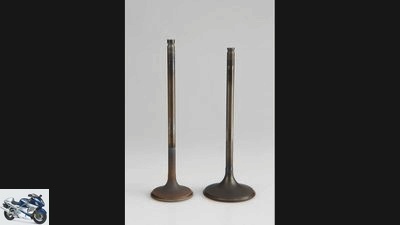
Bilski
26/35
Valves with shafts 4.5 millimeters thick.
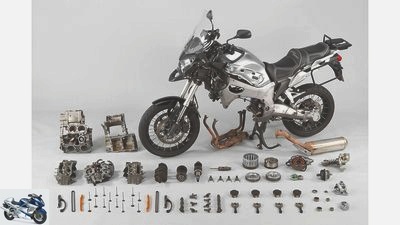
Bilski
27/35
The Honda Crosstourer dismantled into its individual parts.
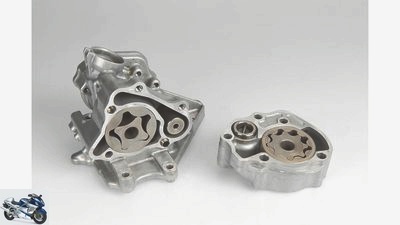
Bilski
28/35
A total of three oil pumps build up the hydraulic pressure for engine lubrication and dual clutch transmission. The pumps withstood the endurance test and the automatic and manual switching absolutely flawlessly.
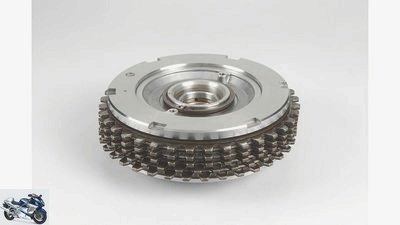
Bilski
29/35
Two couplings sit one behind the other on a shaft.
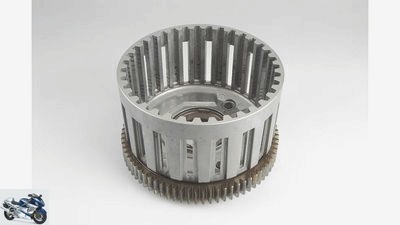
Bilski
30/35
The huge clutch basket shows deep chatter marks.
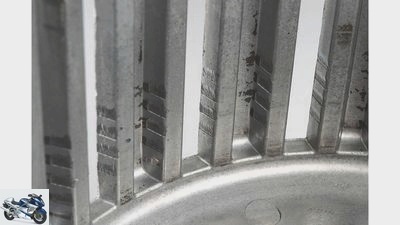
Bilski
31/35
These chatter marks would be caused by the plates of the inner clutch.
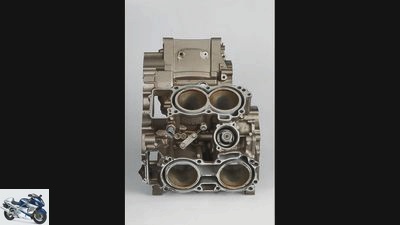
Bilski
32/35
The engine housing is compact thanks to the narrow 76 degree cylinder angle.
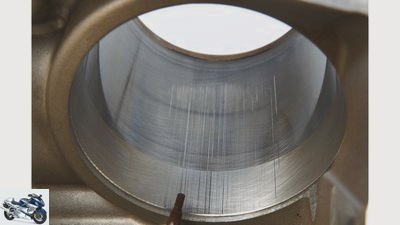
Bilski
33/35
Noticeable in the coated cylinder liners: clear traces of friction. Indicates revving when the engine oil is cold. Wouldn’t be a glory sheet for the driver…
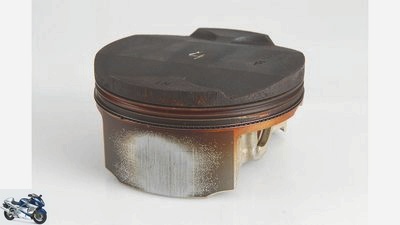
Bilski
34/35
The counterpart: the 81 pistons also show clear signs of running, on three pistons with light rubs. The piston rings and the running clearance over 50,000 kilometers did not suffer.

www.
35/35
On a long journey. The 1200cc Honda quickly reeled off the 50,000 kilometers in our endurance test.
Endurance test final balance of the Honda Crosstourer
Enter new territory
This adventure bike combines a lot of exclusive technology: a V4 drive with cardan in the aluminum bridge frame, garnished with Honda’s unique dual-clutch transmission. Technology that works in the long term?
D.he initial situation was appealing: For the 2012 season, Honda put together a completely new package for the travel enduro category: a 129 hp V4 engine with a powerful 1237 cm³, 76 degree cylinder angle and compact Unicam cylinder heads. Garnished with cardan and aluminum bridge frame. Everything from the modular system from the VFR 1200 F sports tourer presented in 2010, tailored to more torque and touring suitability. Also applies to Honda’s exclusive dual clutch transmission (DCT): two clutch packs in a larger clutch basket, actuated electro-hydraulically. Costs 1000 euros extra and increases the weight without accessories by ten to a whopping 287 kilograms.
Buy complete article
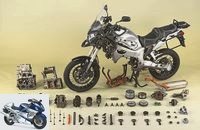
Endurance test final balance of the Honda Crosstourer
Enter new territory
Crosstourer with V4 feeling and double clutch for aha experiences. Shifting without a clutch lever also means shifting without interrupting tractive power. Fascinating when the machine does not jolt when shifting gears, and the pillion’s helmet doesn’t bang against the driver’s. Four out of ten buyers currently choose the DCT.
People like MOTORRAD reader Renato Culjak: “After 20 years of abstinence and actually no driving experience at all, I was honestly very happy to be able to ‘only’ concentrate on driving and braking at the beginning." Honda’s technology also helps drivers with stiff limbs or accidental injuries get back into the saddle. DCT means having all options: being able to switch gear yourself, using Tiptronic with your left hand or using an optional foot lever. But not having to, because the on-board computer changes the six gears automatically in two driving modes. “Perfect for sightseeing and pure pleasure trips", as the author found.
MOTORRAD veteran Mini Koch wrote the Crosstourer kudos in the logbook: “In normal touring operation, the ‘automatic’ and the double clutch function very well." To add: “If you shift manually using the handlebar gear lever, it works well even in hairpin bends with smooth transitions when downshifting, and on long stretches with many gear changes it is absolutely first class. Which you only really notice when you switch directly to a GS 1200 or Multistrada. Super class with full loading out of curves, because you know how and why Pedrosa and Márquez do the meters."
High fuel consumption
Gargolov
Off-road use cost overcoming because of the high weight and center of gravity.
The smooth running smoothness well beyond medium speeds also earned a lot of praise. But it also set criticism. For example in the high gasoline consumption of an average of 6.8 liters per 100 kilometers – evidence of many motorway tours. In city traffic, on the other hand, the D-mode shifts imperceptibly softly, but also up very early. This makes the V4 appear jerky in the lowest revs. In addition, there are strong load change reactions and clear clacking noises when automatically downshifting, for example when coasting down in front of red lights. The shift points are different in the sporty S mode. Now the V4 turns almost too high. He keeps fourth in it for a long time when re-entering after overtaking. At 130 km / h.
And using the “kick-down” function, when the gas is opened, it shifts down to two gears. Many drivers therefore preferred to dictate their will to the engine, shifting gears manually or by foot. Both works at any time, even during the automatic modes. Generally speaking, a little load makes gear changes smoother. More gas makes it gentler here. In push mode, however, there was clear play in the drive train. Since the cardan shaft is not mounted in, but below the swing arm axle, length compensation is necessary for compression and rebound. According to Honda, this homokinetic joint can sometimes make noises.
From around 15,000 kilometers on, complaints about a clutching clutch that was difficult to dose when starting up increased. Felt as if the clutch was actuating first gear digitally: engages, does not engage, engages … This irritating phenomenon occurred particularly with tough, cold engine oil (cold start!) And made turning, driving down curbs and getting into flowing traffic more difficult. “I wish I had a conventional clutch lever as a dimmer” was written in the logbook.
What the Honda delegation said at the end of the endurance test: “With DCT, starting and turning on a hill can be controlled just as sensitively using the throttle grip as with a clutch lever. That also works, is a mandatory task in the specification sheet. The double clutch cannot engage in a ‘wave-like’ manner – one clutch establishes the frictional connection to the extent that the other releases it for the previous gear pair. We are not aware of any problems with any of our DCT models, including the NC 700. We have no explanation why this behavior only occurred with higher mileage. We have not received any similar feedback from the market either. “
Sit down, drive, after work
With an impressive 1237 cm³, the Honda Crosstourer is one of the largest machines in its class.
Only a few of the many communications dealt with this topic. For example that of Norbert Klapproth: “Double clutch in a motorcycle is a stroke of genius. Never again without it! However, the clutch could act a bit more sensitively in slow driving mode (maneuvering, turning in the tightest of spaces, etc.). ”In general, the owners of their road enduro vehicles move an above-average amount, usually around 10,000 kilometers per season. And in doing so, they made experiences that are remarkably similar to those of MOTORRAD. It starts with the essential experience: no oil consumption, no breakdowns, no defects worth mentioning. Nowhere. With all owners there were only trifles, if at all. The rule is: sit on it, drive, after work.
Criticism mostly concerns expensive factory accessories (plastic luggage system in aluminum look for around 1500 euros!) And steep replacement part prices. About spark plugs for 45 euros each. Fortunately, it only took four new ones over 50,000 kilometers. For 80.40 euros at the rear and 63.23 euros per set at the front, brake pads are also really no bargains. Need an air filter? Here you go, for 73.14 euros. Nevertheless, the costs in the final balance are overall limited. Because practically nothing breaks.
Okay, there were little nicks. Insufficient splash protection on the rear wheel, for example. Or high brake pad wear and scratching front brake discs. On some customer motorcycles, the windows were then replaced under warranty. Those of the endurance test specimen are just now at Honda for assessment after the unwound 50,000 kilometers. During the long-distance test, the hydraulic preload of the strut failed – the adjustment mechanism was mechanically locked. As with customer machines that were also affected by this, this only related to the lifting of the spring base, i.e. adaptation to the load, not the springs themselves.
We have to ascribe ourselves to ourselves “worn” brake pads on the parking brake on the rear disc: In view of the high-torque V4, did someone drive off with the handbrake on? Seriously: The locking lever is quite inconspicuous, a warning light is missing in the not overly informative cockpit.
A mere 305 kilograms
Jahn
With a passenger at the 2012 Alpine Masters.
Overall, the Crosstourer does little credit to the otherwise so good Honda ergonomics: The wide handlebar rests on risers that are too high for small riders, far away. And, depending on your stature, it sometimes pinches and pinches on the standard bench seat after just two hours. MOTORRAD had the uncomfortable seating furniture by Yves Moillo / BD Germany comfortably upholstered into a gel bench. On the original substructure of a second bench. Many owners also have their bench seat upholstered. The target group are more seasoned drivers from 1.80 meters in height. Because the Crosstourer is a large, heavy motorcycle with a high center of gravity. Must be able to hold.
All the more incomprehensible that the Crosstourer only allows a small load: With suitcases, main stand and top case, the load with a full 21.5 liter tank already weighs 305 kilograms. Then the all-terrain Gold Wing will only have 174 kilograms of payload. Not much. While we’re at the point of criticism: the windshield of the short standard screen and its cumbersome adjustment mechanism didn’t really suit any driver. Honda’s high touring windshield provided better protection, but the wind roared loudly around the ears of some drivers: “The turbulence is quite weary,” wrote the managing editor Harry Humke.
What I liked: the stable, fairly balanced chassis of the long-legged tourer. However: with a topcase and suitcases (and with slightly worn tires) the 1200 commuted on German autobahns near top speed (209 km / h). Chassis specialist Mini Koch criticized the upside-down fork: “The fork does not respond to hard edges and bumps and gets stuck, which makes the whole front tremble.” The deputy test boss Andi Bildl was also bothered by the stubborn fork.
Unfortunately, it was not always possible to avoid falling over on impassable terrain. “The weight kills you,” wrote a service editor after such an incident. The engine still running for a brief moment could be a cause of friction marks in the connecting rod bearings after dismantling. The housing cover of the double clutch protrudes from the right side of the engine in an exposed manner, i.e. at risk of falling. Honda’s accessory protection bar made of soft aluminum can hardly protect it. But luckily, the lid is not damaged, just got small scratches.
Perfect condition after 50,000 kilometers
The “moment of truth” comes in the face of the dismantled engine. And there the VFR 1200 XD presents itself externally and internally in impeccable condition. In principle, you can reinstall all the engine internals without hesitation after the assessment: valves, the two compact camshafts and the triple slide-bearing crankshaft, everything is great. Likewise the huge gear wheels or the shock absorbers in the cardan. Only one inconsistency occurred: According to the Honda workshop manual, the coated cylinders cast into the engine housing were outside the tolerance. Theoretically. But because the piston clearance is flawless, the value for the wear dimension seems to have slipped 0.1 millimeters – see Honda’s answer above.
Conclusion: “Adventure” has nothing to do with durability on this motorcycle. The reliability is outstanding. No wonder that the owners of a cross tourer are extremely satisfied. Compliments for fifth place among 39 endurance test machines! Honda is breaking new technical ground with no regrets.
Measured values, balance sheet, costs and maintenance
BILLION
The performance diagram of the Honda Crosstourer.
With a dual clutch transmission, only the power on the rear wheel can be determined on the roller dynamometer, back calculation to the crankshaft is not possible. The positive result: full 112 hp instead of 106 hp at the start of the test.
| Measurement according to | 4647 km | 50355 km | |
| acceleration | |||
| 0-100 km / h | sec | 4.0 | 3.9 |
| 0-140 km / h | sec | 6.4 | 6.4 |
| 0-180 km / h | sec | 15.5 | 15.3 |
| Draft | |||
| 60-100 km / h | sec | 4.3 | 4.1 |
| 100-140 km / h | sec | 4.8 | 4.9 |
| 140-180 km / h | sec | 5.9 | 5.7 |
| Average consumption over 50,000 km | |||
| Fuel (super) | l / 100 km | 6.8 | |
| Engine oil | l / 1000 km | 0.0 | |
Balance after 50,000 kilometers
BILLION
The wear and tear on the Honda Crosstourer.
Cylinder head: An exhaust and an intake valve are slightly leaking, the compression of all cylinders is okay, even, at a high level. The valve guides and shafts show only minor wear, as do the camshafts and rocker arms including bearings. The valve seats are only slightly wider.
Cylinder / piston: All cylinders exceed the presumably incorrect wear dimension in at least one point. Like the pistons, they show clear signs of running on three pistons with slight rub-offs. The piston rings are fine.
Crank drive: Three connecting rod bearings show slight traces of friction, one associated with material eruption. The crankshaft main bearings have a uniform contact pattern and only moderate running tracks. Piston pins and connecting rod eyes are inconspicuous.
Power transmission: The clutch basket shows strong chatter marks in the engagement area of the second hub and weak chatter marks in the area of the first hub. Gear wheels / shafts as well as the switching mechanism show hardly any wear, the play of the two friction disk sets is not increased. Final drive / cardan shaft are without any abnormalities.
Frame / chassis: The coating of the frame and the paintwork are in good condition. Steering head and swing arm bearings work without play, footrests and other lever bearings are okay.
Costs and maintenance
costs
| Operating costs over 50,000 kilometers | |
| 19.5 liters of oil at 15.89 euros | 309.86 euros |
| 5 oil filters at 14.67 euros | 73.35 euros |
| 3 clutch oil filters at 15.12 euros each | 45.36 euros |
| 2 air filters at 73.14 euros | 146.28 euros |
| 4 spark plugs at 44.99 euros each | 179.96 euros |
| 1 set of rear brake pads at 80.40 euros | 80.40 euros |
| 6 sets of front brake pads at 63.23 euros | 379.38 euros |
| 1 set of brake pads for the parking brake at 91.90 euros | 91.90 euros |
| Small parts, lubricants, brake fluid | 79.29 euros |
| Seals | 3.05 euros |
| Inspections and repairs | 1268.36 euros |
| Tires (including assembly, balancing and disposal) | 1207.28 euros |
| fuel | 5532.90 euros |
| total cost | 9,397.37 euros |
| acquisition cost | 14790.00 euros |
| Depreciation | 5790.00 euros |
| Estimated Price (Dealer Selling Price) | 9,000.00 euros |
| Costs per kilometer (without loss of value) | 18.8 cents |
| Costs per kilometer (with depreciation) | 30.4 cents |
Maintenance and repairs
| km | |
| Front and rear tires renewed, Conti Trail Attack | 8943 |
| Brake pads renewed in front | 8987 |
| 12000 inspection (Cost: 173.40 euros) | 11527 |
| Front and rear tires renewed, Conti Road Attack 2 | 21500 |
| Seat lock loose | 23339 |
| 24000 inspection (Costs including front brake pads and brake pads of the parking brake: 878.46 euros) |
24903 |
| Seat lock stuck | 24970 |
| Rear brake pads renewed | 26654 |
| Rear tire renewed, Conti Road Attack 2 | 30505 |
| Front brake pads renewed | 33812 |
| Front and rear tires renewed, Dunlop Trailmax TR 91 | 35271 |
| Suspension strut adjustment handwheel defective (guarantee) | 35679 |
| 36000 inspection (Cost including brake lever: 273.26 euros) | 38904 |
| Front and rear tires renewed, Pirelli Scorpion Trail | 41849 |
| Manifold seals renewed (guarantee) | 45804 |
| 48000 inspection (Costs including front brake pads: 966.21 euros) |
48 76 |
Reading experiences
www.
On a long journey. The 1200cc Honda quickly reeled off the 50,000 kilometers in our endurance test.
I was already enthusiastic about the test drive on the DCT model. My son found the pillion comfort comfortable – our new family tourer was found. Since June 2012, the Honda has reeled over 20,000 kilometers on extended tours without problems or defects. The V4 engine is awesome. I retrofitted protective grille for the water cooler, rear wheel cover and case system from SW-Motech made of aluminum. The series windshield was dismantled because, with my height of 178 cm, I couldn’t find a compromise with the turbulence behind the windshield. After Pirelli Scorpion Trail and Dunlop Trailmax TR 91, my current tire recommendation is the Continental Trail Attack 2: It leaves nothing to be desired with the longest durability. “
“Hauki”, Riesa on the Elbe
“The motorcycle fits my 1.98 meters very well. In addition to the ex-demonstrator, there was a Leo Vince exhaust system and a set of suitcases from SW-Motech. The great V4 has just enough power from 5000 rpm. But sporty driving has an impact on consumption. It’s hard to go under seven liters per 100 km; if it gets down to business quickly, it will be up to nine liters. At first I had a pulsation in the handbrake handle when braking between 70 and 50 km / h. At the 12000 inspection for 402 euros, new brake pads at the front fixed this problem. The Metzeler Tourance Next works wonderfully: Full grip allows deep slopes, it cautiously announces slips and offers a high level of safety even when wet. “
Eckehard Bosenick, Meinersen
“The Crosstourer shines in every terrain: worst roads in Romania, highways, race tracks, passes in the Alps – more than 24,000 kilometers in twelve months. The front brake discs rub slightly, they are replaced under guarantee. The powerful engine is agile on the gas and offers more than enough power at all times. The V4 consumes between five and six liters with a brisk driving style. The high accessory windshield offers sufficient wind and weather protection. Long motorway journeys are no problem with air cushions on the seat. When maneuvering, you notice the heavy weight, but if the load rolls, it drives playfully. The DCT is awesome. Shifting without interruption of tractive power brings unique propulsion. Automatically or manually, you can change gears in the middle of the curve without bringing any unrest into the line. However, the D-mode shifts to sixth gear much too early, at 60 km / h according to the speedometer (real 53 km / h). This leads to valve jerking that I know from BMW. That’s why I always drive in the manual mode in built-up areas. Compared to the KTM and BMW, the chassis offers too few adjustment options. “
Hans Eifler, Bonn
“Since August 2012, my DCT has run 22,000 kilometers without any defects or any problem. A typical Honda. Their expensive original side cases are perfect: easy to assemble, keyed alike and beautifully slim. Only the topcase wasn’t waterproof, so I got one from Givi in exchange from the Honda dealer. I had the seat upholstered by three centimeters and installed a Givi windshield with an adjustable spoiler. The front brake pads are finished after around 10,000 kilometers. Is it perhaps the double clutch? The Honda is a sporty touring machine for tall people – not enduro! Their narrow tires are cheaper than wide touring tires. A good choice: Conti Trail Attack 2 – completely curvy and flawless even in the wet. “
Herbert Putzer, Kramsach / Austria
“Since May 2012 I have unwound 39,500 kilometers in 2012. I am very satisfied with the machine. She only had to go to the workshop once, unscheduled: the defective strut (adjustment mechanism) was replaced under guarantee. The tire wear is much lower with the Continental Road Attack 2 than with the first tires: The Contis last 20,000 kilometers at the front and 15,000 kilometers at the rear! Positive: Cardan and exact range display. “
Viktor Arendt, Filderstadt
“This Honda is inconspicuous in a good sense over 26,700 kilometers: no repairs or defects. Inspection and wear parts only (brake pads after 16,500 km). Quiet engine and drive, except for the load change impact (but is much stronger with the VFR 1200 F). Range of up to 390 kilometers possible, then exactly 21.7 liters. At over 130 km / h, my height of 1.85 meters with the high touring windshield showed slight turbulence. The MRA attachment window provided a remedy. “
Bernd Schmiade
“Great touring machine with too little steam from the bottom. V4 with completely disappointing engine characteristics. In second gear he just can’t get out of the curve. Nothing happens up to 4500 rpm, only then do the arms become long. From a 1200 V4 I expect more torque at low revs. The too long overall gear ratio and the unsuccessful shift gradation unnecessarily increase the problem. Positive: excellent handling for this weight class. “
Rolf Schoch, Rickenbach / Switzerland
“Engine torque and elasticity are first class. However, the V4 should be used in slow driving areas such as traffic jams, city tours and the like. Ä. ideally only be driven in first gear. Load changes and the tremendous jerking are huge nerves. There is a fear that the engine or transmission will be damaged. The gearbox gets stuck, it hits first gear so hard that the machine jerks reluctantly. Only in one out of ten cases is it possible to shift from second gear to neutral despite sensitive operation. The motorcycle can also be steered easily in tight corners. The inadequate splash protection is unbearable: extreme soiling in the front wheel area, on the engine or radiator front and in the rear area. “
Manfred Eichhorn
Honda takes a stand
Hertler
Blue and red shirts: Honda employees Klaus Bescher (3rd from left), Oliver Franz (middle) and Guido Noewak (2nd from right) inspecting the interior of the engine.
… to the center of gravity and great weight.
The centralization of the masses was a top priority in the development. The technical components are stably constructed to guarantee the high Honda standards of quality and durability.
… for the low payload of less than 180 kilograms with suitcases and crash bars.
The maximum load without accessories is 194 kilograms.
… to the permanently uncomfortable, non-height-adjustable bench.
Compromises have to be found for long-distance comfort, because the seat height should still be moderate. The Crosstourer has no height adjustment because we didn’t want the weight to get too big.
… too high consumption (6.8 l / 100 km).
This is where weight and air resistance have an impact. The vehicle has wide handlebars and was mostly moved by MOTORRAD with a full luggage system and high touring screen. The high wear on the brake pads also shows that the VFR 1200 X was driven quite dynamically. In general, however, the requirement in development – lower fuel consumption than the predecessor Varadero 1000 – was met.
… to the no longer usable handwheel on the spring front leg.
There were isolated problems with a stiff adjustment mechanism. It is only a malfunction in the preload mechanism because the shock absorber continues to work. Investigations are still ongoing into the causes; affected struts were replaced under warranty.
… to the chatter marks in the clutch basket.
The clutch for gears two, four and six is located here. The chatter marks appear where the most load is on it. They have nothing to do with the “starting scratching” described by MOTORRAD. These are normal running tracks; the clutch basket can be used without hesitation.
… to tracks on cylinders and pistons.
Since no oil consumption was to be measured, no novel noises occurred and the performance has even increased, this is not a worrying issue. Such a finding can sometimes occur before a mileage of 50,000 kilometers without affecting the function of the engine.
… to tracks in the connecting rod bearings.
Since the coating is intact, these tracks probably appeared during processing or installation.
… to the worn (expanded) cylinders according to the Honda dimension table.
The bore is probably only worn over 81.125 millimeters, not as stated at 81.025 mm. This “missing” tenth of a millimeter would explain why the piston play is flawless, otherwise there would be no logical explanation. However, we are still waiting for the final comment from Japan.
Offers used Honda Crosstourer in Germany
1000PS marketplace app
The DCT versions are popular on the used market.
On the used market you have the choice between two Honda Crosstourers: with or without DCT transmission. Versions are available in good numbers and line up at the price level of the competition. Here is a current overview of the market situation: used Honda Crosstourer in Germany.
Related articles
-
Honda Crossrunner and Crosstourer DCT in the test
Bilski family duel: Honda Crossrunner and Crosstourer DCT Honda Crossrunner or Crosstourer DCT? Crusaders are commonly found on the seas of this …
-
Triumph Thunderbird put to the test: 50,000 kilometers of endurance test
mps-Fotostudio long-term test result for the Triumph-Cruiser test: 50,000 kilometers with the Triumph Thunderbird The Thunderbird 1600, together with the …
-
Photos: fact 11 pictures Honda 1/11 Honda CBR 600 F Honda 2/11 Honda CBR 600 F Honda 3/11 Honda CBR 600 F Honda 4/11 Honda CBR 600 F Honda 5/11 Honda CBR …
-
fact 12 pictures fact 1/12 Top brakes: radially screwed six-piston stoppers, ABS and integral actuation. fact 2/12 Builds compact and very narrow: the …
-
Comparison test of the sports tourers from BMW and Honda
fact 12 pictures fact 1/12 Top brakes: radially screwed six-piston stoppers, ABS and integral actuation. fact 2/12 Builds compact and very narrow: the …
-
Endurance test final balance of the Yamaha YZF-R1
22 pictures Yamaha 1/22 Yamaha 2/22 Yamaha 3/22 Yamaha 4/22 Yamaha 5/22 Yamaha 6/22 Yamaha 7/22 Yamaha 8/22 Yamaha 9/22 Yamaha 10/22 Yamaha 11/22 Yamaha …
-
Yamaha YZF-R1 in the 50,000 km endurance test
Jacek Bilski 50 pictures Rossen Gargolov 1/50 The Yamaha YZF-R1 has passed the MOTORRAD endurance test. It took her almost 3 years for the 50,000 km …
-
Endurance test final balance Triumph Sprint ST
Bilksi endurance test final balance Triumph Sprint ST Well done No doubt, the Triumph Sprint ST is one of the most dynamic and powerful …
-
Endurance test final balance of the Kawasaki Z 1000
Gargolov Endurance test final balance Kawasaki Z 1000 The naked bike after 50,000 km With the Kawasaki Z 1000, the 40-year tradition of the Z series …
-
Endurance test KTM 950 Adventure
Photos: Jacek Bilski long-term test KTM 950 Adventure The mill rattles … … but it lasts. Despite constant rattling noises, the KTM 950 …